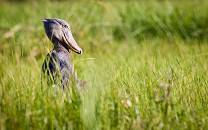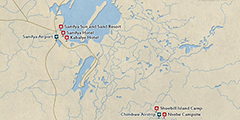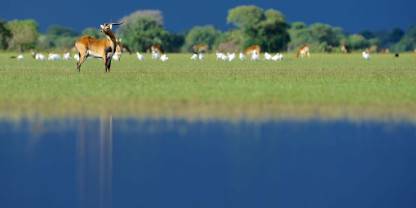Bangweulu Wetlands, a community-owned protected area, is one of Zambia’s prime birding destinations thanks to the presence of the rare, sought-after shoebill. A mokoro (wooden dugout canoe) trip into the heart of the wetlands to look for these prehistoric-looking birds is a special experience. You’ll also have a chance to interact with the local communities as they practice traditional fishing and beekeeping.

-
Best Time To Go
- May to July (Shoebills and black lechwe)
-
High Season
- Never (The park is never busy)
-
Size
- 6,000km² / 2,317mi²
-
Altitude
-
1,160-1,186m /3,806-3,891ft
 View Photos
View Photos
 View Photos
+24
Photos
View Photos
+24
Photos
 Open Map
Open Map
Pros & Cons
- Home to the endemic black lechwe
- Excellent birding opportunities
- A chance to see shoebill
- Community-owned protected wetland
- An opportunity to meet local communities
- Activities include game drives, walking safaris and mokoro trips
- Little-visited off-the-beaten-track destination
- Good park management under African Parks
- Limited game-drive circuit
- Very seasonal destination
Wildlife
Bangweulu is not a classic wildlife destination. It is, however, the main stronghold of the endemic black lechwe, a graceful semi-aquatic antelope that is certain to be encountered in huge herds. Several cheetahs have recently been reintroduced and the floodplains are the perfect hunting ground for these sleek big cats. But the main attraction for most visitors is the rich birdlife.
More about Bangweulu Wetlands' wildlifeScenery
Bangweulu, meaning ‘where the water meets the sky’, is an extensive wetland located in a shallow depression fed by 17 rivers. The water level in the center varies between 1m and 2m (3.3ft and 6.6ft), causing the perimeter of the wetland to advance and retreat over 40km/25mi between the seasons. This seasonal floodplain is the habitat on which the endangered black lechwe and many other creatures depend.
Weather & Climate
Bangweulu has a tropical climate that sees average daytime temperatures staying uniform throughout most of the year. The exception is the transition from Dry season (May to October) to Wet season (November to April), when temperatures go up by a couple of degrees. Rain and heat both diminish in the drier months.
More about the weather and climateBest Time To Visit
May to July, early in the Dry season, is the best time to explore the wetlands. During these months the lechwe are abundant on the floodplains and the water level has retreated enough for game drives. Later in the Dry season the female lechwes retreat deep into the wetlands, which makes them difficult to see. The area becomes mostly inaccessible in the Wet season.
More about the best time to visit


